

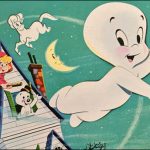
“There are some people who believe in ghosts. And there are some people who don’t. If you are the ‘believe in ghosts’ kind, then this story is about one. And if you are the ‘don’t believe in ghosts’ kind, well, just for fun, this story is about one anyway. His name was Casper, and he was surely the most unusual ghost there ever was or wasn’t, depending on how you feel about it.”
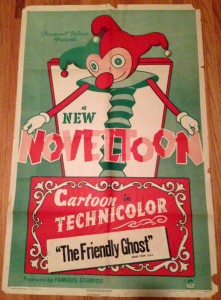 That’s how one of the most famous and genial animated characters was first introduced by a narrator in the 1945 short subject, The Friendly Ghost. As the title suggests, it marked the debut of Casper, the spirited spirit who would scare up popularity without scaring anyone and become beloved by audiences.
That’s how one of the most famous and genial animated characters was first introduced by a narrator in the 1945 short subject, The Friendly Ghost. As the title suggests, it marked the debut of Casper, the spirited spirit who would scare up popularity without scaring anyone and become beloved by audiences.
As this fall marks the 80th anniversary of Casper’s debut, and with it being the Halloween season, it’s the perfect time to look back at his first cartoon, The Friendly Ghost, how he first floated onto screens, and his not-so-scary afterlife in film, TV, and comics.
The Famous Studios “Noveltoon,” directed by I. Sparber, opens with the narration (from Frank Gallop), after which we are taken into a haunted house, where Casper (Walter Tetley) has fallen asleep reading the book, How to Win Friends.
Every night at midnight, his brothers and sister ghosts all “scamper out” to frighten the neighborhood’s people, springing to life from the white sheets covering the furniture, and flying out, shrieking and booing into the night sky.
But Casper doesn’t go; he doesn’t want to scare anyone, he wants to make friends. He’d rather stay home, even as one of the other ghosts tries to get him to go. Casper watches from the window as the ghosts fly into the night sky.
As the other ghosts descend upon a nearby town, scaring the residents, Casper decides to run away from home, tying a sack to a stick and carrying it over his shoulder.
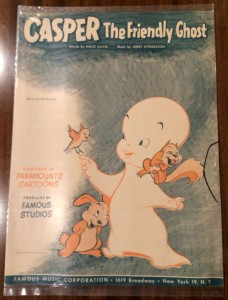 As he makes his way, he tries to make friends by greeting those he comes in contact with, but he manages only to scare everyone, including a rooster, a mole, a cat, a mouse, and an entire henhouse.
As he makes his way, he tries to make friends by greeting those he comes in contact with, but he manages only to scare everyone, including a rooster, a mole, a cat, a mouse, and an entire henhouse.
Poor Casper laments, “It’s no use, I’m just a scary old ghost.” So, he lies down on the railroad track to end it all (odd, as he’s a ghost), and when the train passes, it has no effect, and he simply tumbles off the track.
As he sits, crying, a young boy and girl, named Bonnie (Cecil Roy) and Johnny (Mae Questel), come over. They say, “Hello,” and they aren’t afraid of him. In fact, they ask him to play.
The children invite Casper home, but their mother is terrified and throws Casper out. However, at that moment, the bank manager (Jackson Beck) shows up, looking for payment for the mortgage, and when he sees Casper, he decides that since the house is haunted, they can keep the mortgage, and he runs off.
Mom is so grateful, she picks up Casper and brings him back into the house. The final happy ending scene of the short reveals the mother sending Johnny and Bonnie off to school with a happy Casper dressed for school and heading off to the schoolhouse with them.
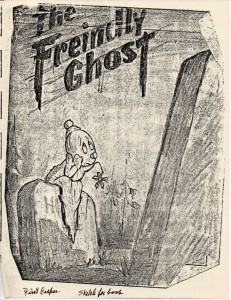 The character of Casper was created by artists Seymour Reit and Joe Oriolo. As Reit discussed in a 2019 Cartoon Research article by Jim Korkis: “One weekend I wrote a three to four page story I titled ‘Casper the Friendly Ghost.’ The story was mine – every last word. Shortly after, I gave it to Joe Oriolo, who wanted to develop the visuals and perhaps peddle it either to the studio or to a children’s book publisher.
The character of Casper was created by artists Seymour Reit and Joe Oriolo. As Reit discussed in a 2019 Cartoon Research article by Jim Korkis: “One weekend I wrote a three to four page story I titled ‘Casper the Friendly Ghost.’ The story was mine – every last word. Shortly after, I gave it to Joe Oriolo, who wanted to develop the visuals and perhaps peddle it either to the studio or to a children’s book publisher.
“By that point, Gulliver [at the Fleischer Studio] was finished, the studio was in hock to Paramount Pictures, and many of the 600 artists (including me) started drifting north again, out of jobs. For a little while, I worked at Eisner & Iger, drawing comics pages.
“Then along came Pearl Harbor and WWII. Am proud to say that I went into the army in a camouflage unit; later went to OCS and wound up in Europe on the staff of the Commanding General of the 9th Air Force, Gen. Hoyt Vandenberg.
“In this job (thanks to my art background) I worked on maps, photo presentations, charts, and various graphic reports which went to Eisenhower at SHAEF. (Pretty heady stuff for a sheltered young kid!) I came out of the Air Force after VE Day with a Captaincy and a decoration. Back to the real world!
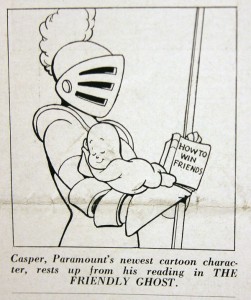
Promo art published in PARAMOUNT SALES NEWS, September 6th, 1945.
The Friendly Ghost was eventually released by Famous Studios, the successor to Fleischer after Paramount purchased the latter.
Most animated characters evolve from their first appearance, and Casper is no different. In The Friendly Ghost, he is pudgier and even more childlike. As Steve Stanchfield noted in his 2020 Cartoon Research article: “Casper’s personality is pretty simple in this first entry, but (arguably) just as so many of the other cartoons Famous was doing in this period, it’s charming and sweet without being too saccharine. I especially like his design here in the first cartoon—it might be the cutest starring character the studio ever produced. His action and poses are simple and charming throughout in a sort of Little Lulu way.”
With lush, cozy backgrounds by scenic designer Shane Miller and animation from such talents as Tom Golden and Nick Tafuri, The Friendly Ghost features innocent personality animation that allows the audience to empathize with Casper, as well as dynamic sequences. One includes the ghosts descending on a small town like bomber jets, as lights in houses spring on in alarm.
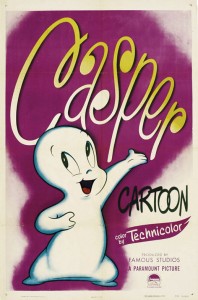 After The Friendly Ghost, Casper went on to star in the shorts There’s Good Boos Tonight (1948) and A Haunting We Will Go (1949). Starting in 1950, he became a mainstay at Famous Studios in his own series of cartoons (with a fun theme song written by Jerry Livingston and Mack David).
After The Friendly Ghost, Casper went on to star in the shorts There’s Good Boos Tonight (1948) and A Haunting We Will Go (1949). Starting in 1950, he became a mainstay at Famous Studios in his own series of cartoons (with a fun theme song written by Jerry Livingston and Mack David).
Casper would star in over fifty cartoons from 1949 to 1959. Many, including artists who worked on the shorts, have joked that the plots of the shorts were somewhat repetitive (Casper, wanting to be friendly, scares most people, until he is finally befriended by someone, who doesn’t seem to notice or care that he’s a ghost). In author Charles Solomon’s book, Enchanted Drawings: The History of Animation, animator Lee Mishkin said, “With the Casper Series, you never knew what picture you were working on, because they were all exactly the same.”
Despite this, Casper was a hit with audiences and went on to have even more success beyond the big screen, becoming the most popular character for Harvey Comics, which purchased the character in 1959, the same year he came to television on the series Matty’s Funday Funnies, and eventually his own show. The comics and small screen opened Casper up to new audiences and generations, helping him to become a pop culture icon.
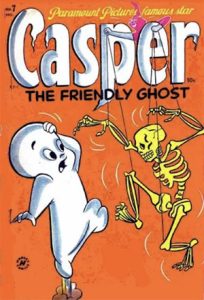 There was a bit of a Casper resurgence in 1979, when the character headlined the Hanna-Barbera cartoon series, Casper and the Angels, which combined Casper with both the Star Wars and Charlie’s Angels popularity of the time. Hanna-Barbera also produced two prime-time specials, Casper’s Halloween Special and Casper’s First Christmas (in 1979).
There was a bit of a Casper resurgence in 1979, when the character headlined the Hanna-Barbera cartoon series, Casper and the Angels, which combined Casper with both the Star Wars and Charlie’s Angels popularity of the time. Hanna-Barbera also produced two prime-time specials, Casper’s Halloween Special and Casper’s First Christmas (in 1979).
Thirty years ago, director Brad Silberling and Steven Spielberg’s Amblin Entertainment brought the Friendly Ghost back to theaters with the big-budget, live-action/animated summer movie, Casper. This was followed by a new TV series in 1996 and another in 2009. Classic Casper can still be seen as part of the MeTV Toons line-up.
Now celebrating his eightieth anniversary, Casper, since his debut in The Friendly Ghost on November 16, 1945, has secured a place in animation history, for people who do and don’t believe in ghosts. The character’s appeal was best summed up by animator Myron Waldman who worked on the original Casper cartoons, and said in author Leonard Maltin’s book, Of Mice and Magic: “The boys at the studio used to kid me when we were doing the Caspers; they’d call them the ‘oooh-aah’ pictures, but I always felt those pictures would last much longer than a picture that was just based on gags, because nobody can remember the gags. When they go to see it again, or talk about it, I think they like a story – kids especially.”